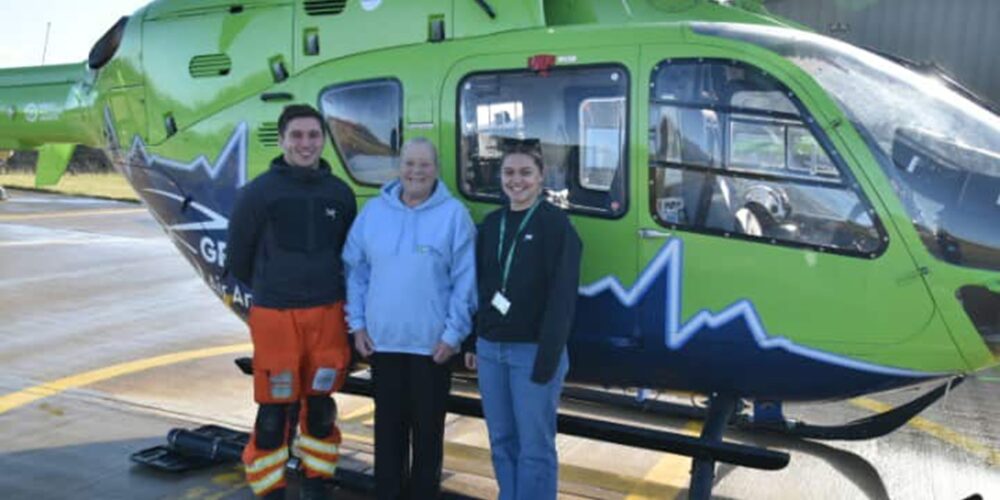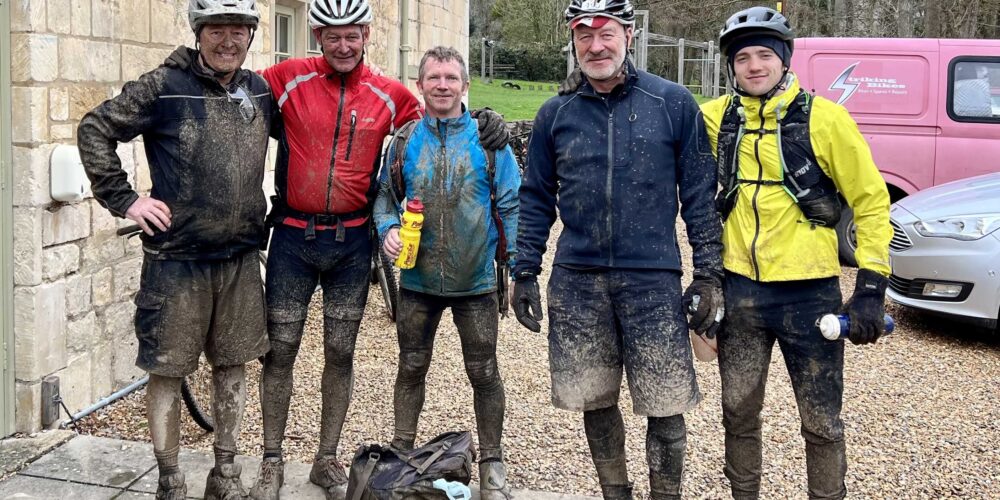
Great Western Air Ambulance Charity shortlisted for six Air Ambulances UK 2022 Awards of Excellence
September 26, 2022
New Sentinels M.R.C raise over £800 for GWAAC at Nailsea International Bike Show
September 30, 2022On 27 June 2022, a small team of Great Western Heartstarters volunteers spent the morning training twelve year-nine pupils on how to do CPR and use a defibrillator at Mangotsfield School in Bristol.
Great Western Air Ambulance Charity (GWAAC) is committed to helping all patients in its region and one of the ways to do this is to educate the next generation in critical lifesaving skills.
Around one-third of our missions are to people in cardiac arrest. And if bystanders can provide CPR and defibrillation within the first two minutes, the patient’s chance of survival doubles.
Teaching school children is a great place to start. The training is delivered in a fun and relaxed environment and the children walk away feeling empowered to be able to help someone in urgent need.
Learning about the chain of survival
The workshop started with Carlota, the Great Western Heartstarters Coordinator, giving a “warm welcome” to the students and an introduction to the purpose and format of the morning’s training.
Carlota asked the students if they knew what a cardiac arrest was; some good answers came back, and she went on to explain the difference between a heart attack (a blockage – think plumbing!) and a cardiac arrest (when the heart stops – think electrics!).
The students were then taught why it’s important to learn CPR and how a defibrillator can help. They were told that the rate of survival from a cardiac arrest is less than 1 in 10 in the UK and although land ambulances aim to reach patients in “approximately 7-10 minutes” (a statistic the students already knew) sadly, due to many reasons, they often don’t hit their target. And for every minute that passes a person’s chance of survival goes down by 10%.
Carlota and the volunteers explained that GWAAC is trying to fill the gap in time and train as many people as possible in CPR and defibrillation. Bystanders are the first link in the chain of survival and if they know what to do, they can buy the patient some time – time for GWAAC or the ambulance to get there.
A dose of reality
After the introduction the students settled down to watch a video – a recreation of a real-life incident that GWAAC attended: a Mum, Cathy, had taken her son to his usual Saturday morning riding lesson when she unexpectedly suffered a cardiac arrest.
The video showed how the CPR that Cathy received from bystanders was a contributing and significant factor in the large chain of interventions that led to Cathy’s survival.
When the video finished the volunteers and students discussed what went wrong and how the bystanders in the video knew that Cathy needed help. The volunteers went on to teach the children how to identify someone having a cardiac arrest and what to do.
It starts with DRS ABC
The students learned that the first thing you need to do is check for danger, so you don’t put yourself at risk when helping someone else. Then they learned how to check for a response and if no response, it’s at this point that they need to shout for help and call 999.
To help decide if the patient is in cardiac arrest, the students learned that you need to check the airway and check for breathing – the volunteers showed them how to do this on a willing participant. If the patient is breathing normally, they need to put them in the recovery position. If the patient is not breathing, they commence chest compressions.
Learning CPR
The volunteers helped explain the mechanics of CPR; they said, “You are being the working heart for that person, helping to squash it down and re-open, allowing blood and oxygen to pump around the body.”
Volunteer Andrew demonstrated the technique, highlighting that the most important thing is to focus on the steady rhythm and to get someone else to help. One student asked, “What happens if no one else is there to help?” Andrew replied, “You need to stay with the patient, dial 999, put your phone on loudspeaker and do CPR.” To allay fears, he told the students, “The 999 call-handler will talk through what to do and will stay with you on the phone until help arrives. You won’t be on your own.”
Volunteer Simon asked the students if they knew where their nearest defibrillator was. They all knew that the school had one, but they didn’t necessarily know where the nearest one was to their home. So, he set them some homework — to find out using defibfinder.uk He advised that they needed to find one within a three-minute round trip.
Using a defibrillator
The students crowded around to watch Andrew and Simon demonstrate how to use a defibrillator and how to count each other in for a change-over when performing CPR (CPR can get quite tiring!). They explained how to attach the pads and how the defibrillator works — it puts you in a 2-minute cycle of performing CPR and then doing a check for the heart rhythm.
Putting it into practice
It was then time for the students to have a go for themselves. In pairs, they practiced performing CPR on the Mini Annes – mannequins specifically designed for teaching CPR.
The volunteers helped the students get in a comfortable position while performing CPR and helped them to get into the right rhythm. The fun bit started when the students sang along to the theme of Baby Shark while doing chest compressions.
They talked among themselves about the “clicking feeling” on the Mini Annes, “feeling tired” and their “hands hurting.” This was a perfect moment for the volunteers to step in, affirm all of the above and say, “That’s exactly why you need a CPR buddy so you can swap when you feel tired.”
The practical session finished with a group CPR tag relay; it was a bit of fun, followed by a sneaky question from Carlota: “Can you remember what DRS ABC stands for?” And much to their teacher’s (should we say) surprise, they didn’t disappoint.
Reflections of the day
The students remained interested and engaged throughout and were full of questions at the end of the workshop. The training had been particularly beneficial to the group because some were working towards their DoE Award, some thought it would be useful for their work in the community and some were hoping to study nursing and medicine at university. One student wanted to be able to help her best friend who suffered from seizures.
When asked what they got out of the workshop, the students said:
“It will help me as a qualified referee. I don’t want anything to happen on the pitch.”
“I’m hoping that if I need it, what I’ve learned today will come back.”
“I didn’t know what a defibrillator was before today.”
“I feel like I know how to respond now.”
“I liked practicing CPR and enjoyed learning how to use the defibrillator.”
“It was clear and easy to follow.”
Amy, Head of PSE, at Mangotsfield School said: “Our aim at Mangotsfield School is to turn our students into decent citizens, so they can thrive in their community. It’s important to include sessions like this into the curriculum so that our young people know what to do in an emergency and can make a positive difference in their community.”
The impact of Heartstarters
At the end of the 2021-2022 academic year, our Heartstarters volunteers taught a total of 3,496 students how to help someone in cardiac arrest. That’s 3,496 more people in the local community, who know what to do to help, than in the previous academic year.
Carlota says, “It’s thanks to schools like Mangotsfield, who understand the benefits of educating young people in CPR, that we are able to spread awareness and equip more people in the community with lifesaving skills.”
If you are basic life support trained and would like to get involved with delivering Heartstarters sessions, why not find out more from the Great Western Heartstarters web page? You can also hear from the volunteers themselves. We hope you will consider whether you would like to educate the next generation on how to save a life.

Students watch on as a Heartstarters instructor demonstrates the recovery position
Our aim at Mangotsfield School is to turn our students into decent citizens, so they can thrive in their community. It’s important to include sessions like this into the curriculum so that our young people know what to do in an emergency and can make a positive difference in their community.

Students put their CPR skills to the test on Mini Anne training manikins
“I didn’t know what a defibrillator was before today.”
I liked practicing CPR and enjoyed learning how to use the defibrillator.



